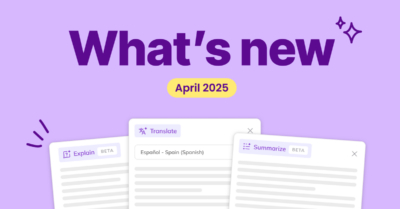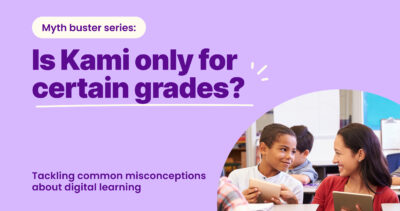Shirin Bradfield
Buscas esto en espaňol, lo puedes encontra aqui.
Blog by Stacey Roshan (@buddyxo), educator, author, keynote speaker, and edtech & innovative teaching consultant.
As I say in Tech with Heart, “A tool is only a tool until it’s part of a solution.”
Edtech is transformative, especially when teachers creatively and meaningfully integrate these tools into the design of their lessons. For language learning, these tools can come in the form of digital flashcards like Duolingo, podcasts, or learning apps, like Kami. Kami is one tool that I’ve seen many teachers leverage to create learning opportunities that wouldn’t have otherwise been possible.
Whether you’re teaching beginners or native speakers, language learning is something that can be taken to the next level with the help of EdTech tools. In this post, I’ll be sharing how Bullis Upper School Spanish teacher Hilary Vellenga has been using Kami Library templates to help her students learn Spanish. If you’re not yet familiar, the Kami Library provides teachers with downloadable, editable, printable, and free resources to help them elevate their lessons.
Let’s dive into several examples of how these Kami templates have been used to help instruct lessons on the Spanish language and allow learners to organize and express new information clearly.
Frayer Model
One awesome template in the Kami Library is the Frayer Model, a graphic organizer designed to help students “better understand new and important concepts by listing examples, non-examples, facts, and definitions.” Ms. Vellenga has creatively used this template to model notes, such as when students are learning new verb conjugations. In this example, she would put the verb in the center box and populate the top two boxes with an English definition and some facts/notes during the instruction phase of the lesson. Students then make their own copy of the Kami worksheet and are tasked with filling in the bottom two boxes with an example and a non-example. To differentiate instruction, students who are finding the task challenging can reference their book and copy an example directly. Advanced students are encouraged to make up their own examples. After students have completed their work, it’s time for group discussion; because all students complete the work in Kami, Ms. Vellenga has access to each file in Google Drive and can easily pull student work up on the board for full class discussion.
Venn Diagram
Venn diagrams are very popularly used in foreign language classes for students to compare and contrast. For example, they might be tasked with comparing regional differences and similarities when learning about new foods, cultures, etc. Kami has several pre-designed Venn diagram templates, making it the perfect tool for this activity.
One fun example I’ve seen was to compare and contrast school menus – one being our weekly school lunch menu and the other from a school in Spain! Students often use Venn diagrams to organize their thinking when reading books in class and to compare characters and their attributes. Venn diagrams are also a wonderful way for students to review vocabulary as it forces students to think deeply and critically as they organize and connect terms. Perhaps a favorite activity is to use Venn diagrams to explore the Spanish vocabulary and familiar Spanish words by discussing foods.
Tournament Bracket
To engage students in some competitive, collaborative fun, Ms. Vellenga likes to use tournament brackets in class. What’s powerful about setting up these brackets in Kami is that students can do the voting, provide feedback, and fill in winners of each level of competition all in one document. The setup is simple – search the Kami Library for “bracket,” and several tournament bracket templates will be displayed. The teacher can open that template with Kami and then add all students as collaborators on the same Kami document.
These templates aren’t exclusively used for teaching Spanish either; Ms. Vellenga’s students recently used a tournament bracket to vote for the best-designed sandwich during their food unit, which could apply to any grade level across a wide variety of subjects. In setting up this assignment, Ms. Vellenga was wondering how she could have all students give feedback and tally votes all in one space; Kami was the perfect solution for her problem!
Bubble Map
Finally, the bubble map template. These types of graphic organizers are awesome for students to organize new information and knowledge in a way that is not strictly linear. One great thing about Kami, too, is that students can not only type text but they can also add media. With this functionality, students can import and insert images and videos. It’s also interesting to see how students choose to organize information in their bubble maps. It’ll give you insight into how students are visualizing what they’re learning and will allow you to better facilitate their growth and understanding. It’s interesting to see how differently students choose to display their information when tasked with creating bubble charts and using similar types of graphic organizers. This visual is a powerful way for students to acquire new knowledge and an important tool in helping students make connections between topics/ideas and structure new information in a way that will stick with them – especially during something complex like Spanish class or learning a second language.
Comic Strips
Though Ms. Vellenga’s students haven’t yet had a chance to use the comic strip worksheets, this is another lesson type that she looks forward to using soon. Comic strips are popularly used across our foreign language classrooms—and especially with Kami—as you can have students use the voice commenting features to retell the story. Once they’ve recited their stories in Spanish, students can practice their listening skills by collaborating and listening to each other’s work. Learning apps like Kami allow your students to practice their pronunciation and speaking skills, and also gives you the opportunity to respond to students directly on the digital worksheet with both text and audio feedback.
As a next step, have students create comics of their own before adding the audio components. As previously mentioned, Kami gives students the ability to search or upload multimedia and clip art, or they have the freedom to draw directly in Kami, too. This type of activity would give Spanish learners a lot of creative flexibility while practicing sentence structure, Spanish vocabulary, pronunciation, and fluency.
I’ve only skimmed the surface of what teachers have been doing in Kami, with language courses and beyond. I hope you’ve enjoyed reading about some of the creative ways Ms. Vellenga has utilized the Kami Library for her Spanish lessons and how it has sparked new ideas for lesson plans and ways for students, from beginner to advanced, can organize their learning.
If you’re interested in reading more about bringing innovative tools into the classroom, head over to my blog, or let’s chat on Twitter!
You may also like

Unlocking understanding: Kami’s latest updates designed for every learner

The state of SPED and ELL technology in 2025

